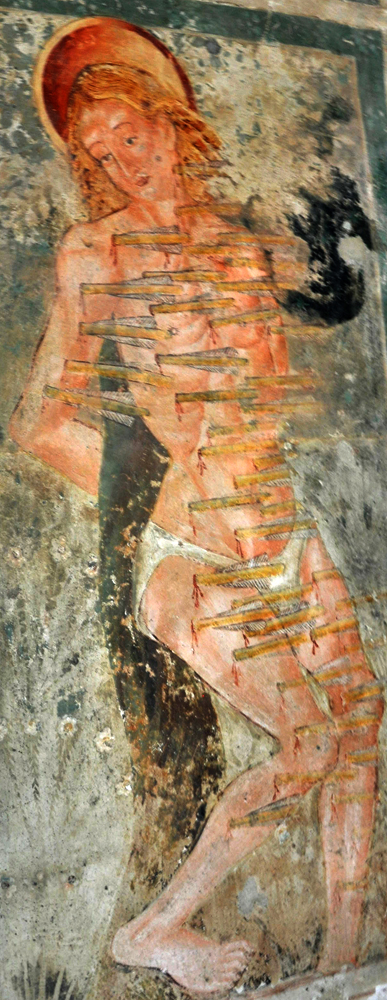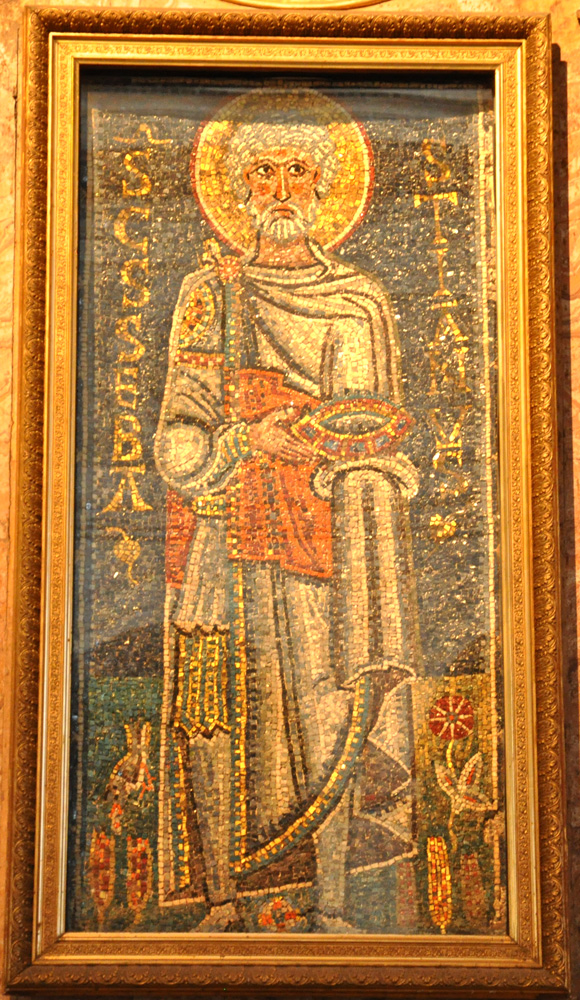The Legend says he was "tied" at the time. Caxton's translation says it was to a stake, but in the art it is almost always to a tree.
The loincloth does not appear to be based on any written source. Some portraits do present the saint fully dressed (example), and some also put the arrows in his hand rather than his body (example). Some go in the other direction and barely cover his private parts with just a swirl of cloth (example) or even less (example).
In a few rare cases a Sebastian portrait features sheaves of wheat. One is the second picture at right, where four sheaves are arrayed left and right of the saint's feet, probably in response to John 12:24-25, "unless the grain of wheat falling into the ground die, itself remaineth alone. But if it die, it bringeth forth much fruit."
NARRATIVE IMAGES
The Golden Legend's story begins with Sebastian encouraging the brothers Mark and Marcellian in their resolve to accept martyrdom (image). His words were so inspiring that many around him were moved to accept the faith, including the young men's father. The father had been suffering from a painful disease, but it left him as soon as he was baptized. When the prefect heard of this he asked Sebastian to cure him too, but Sebastian said his idols would first have to be destroyed (image). Once that was done, the prefect was cured and was baptized along with his family. The pagans then beheaded his son Tiburtius and ran lances through the bodies of Mark and Marcellian. One portrait of St. Sebastian's execution refers to these deaths by the synecdoche of a headless trunk lying at the base of the tree.It was on hearing of all this that Diocletian ordered the archers to execute Sebastian (image). He was left for dead, and a Christian widow named Irene sent for the body so that it could be properly buried. But she found that he was still alive, so she nursed him back to health in her home (image). Four days later Sebastian was back at Diocletian's palace, ready to "rebuke you for the evils you inflict on the servants of Christ." At that, Diocletian ordered his men to beat Sebastian to death with cudgels, staves, or stones, depending on the version.1 Then they were to throw his body into the Roman sewer (image). This was done, though St. Lucina later retrieved it and had it buried near the tombs of "the apostles" (Peter and Paul?).
I have seen only one portrait that uses a staff as an attribute, and none that use a cudgel or stone.
SEBASTIAN AND THE PLAGUE
Paul the Deacon's 8th-century History of the Lombards tells of a plague in the previous century that had beset all of Italy but especially Rome and Pavia (255). It was revealed to a certain man in Pavia that the plague would end there if an altar were built in honor of St. Sebastian. The citizens built the altar, and indeed the plague ended (image). Because of this story Sebastian was looked to as a go-to saint in time of plague. A fresco in Croatia shows him and St. Roch praying to Christ on either side of a huge pile of plague victims. Sebastian and Roch are also paired in many other paintings, especially in the century or so following the Black Death of 1346-53 (example).
Prepared in 2015 by Richard Stracke, Emeritus Professor of English, Augusta University, revised 2015-11-09, 2016-11-14, 2019-02-06.
HOME PAGE

Fresco by Vincent de Kastav, 1474 (See description page)

Sebastian in a 7th-century mosaic in Rome (See description page)

In Oaxaca, Mexico (See description page)
MORE IMAGES
- 15th century: Sebastian as a well-dressed Italian youth.
- Late 15th century (?): A fresco in Galicia juxtaposes Sebastian's passion with Christ's.
- 1500: Giovanni Buonconsiglio's classicizing St. Sebastian with St. Roch and St. Lawrence pictures Sebastian's body pierced by only one arrow.
- 16th century: St. Sebastian is prominently positioned in Marco Moro's The Trinity and All Saints, with the arrows in his hand rather than stuck in his body.
- 1504: This Madonna and Child is flanked by the two plague saints, Sebastian and Roch.
- 1513-14: Paired with St. George in the Costabili Polyptych
- Late 16th century (estimate): Madonna and Child with SS. Sebastian, Roch, and Monica.
- Circa 1600: Altarpiece of Our Lady of Mercy, flanked by SS. Sebastian and Roch.
- 17th century: Painting in the Franciscan Museum, Dubrovnik.
- 1695: St. Irene Nursing St. Sebastian, Passau Cathedral, Germany.
- Late 17th to mid-18th century: Trevisani's St. Sebastian and St. Roch at the Church of San Vidal, Venice.
- 17th century (estimated): Statue outside the Church of St. Sebastian in Trogir, Croatia.
- 1702-1703: Michele Maglia's statue of Sebastian over the colonnade at St. Peter's Square in Rome.
- 1817: Sebastian's portrait in Palermo's Palatine Castle adopts Orthodox iconography.
- Undated: Statue of St. Sebastian at the same church.
- Undated: Three Plague Saints in a painting the Scalzi Church, Venice.
DATES
- Feast day: January 20 Catholic, December 18 Orthodox.
- Died 287
BIOGRAPHY
- Golden Legend #23: html or pdf.
- Roman Breviary: 1908 English translation, I, 697-98; 1632 Latin version, 800.
- Acta Sanctorum, January vol. 2, 257-96.
ALSO SEE
NOTES
1 Graesse, Legenda Aurea, 112. Early South English Legendary, 180. For Caxton's paragraph follow this link.